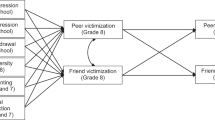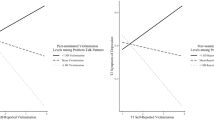Abstract
In past research, relational and physical forms of peer victimization have been identified that have been shown to be significantly associated with social–psychological maladjustment. These forms of victimization, although studied primarily within the group peer context, also occur within dyadic relationships such as friendships. Gender differences in friend victimization and the association between friend victimization and children's social–psychological adjustment were examined. Results showed that boys were more physically victimized by their friends than were girls. Girls were more relationally than physically victimized by their friends. Friend victimization was related to adjustment difficulties for both boys and girls; however, friend physical victimization was particularly related to boys whereas friend relational victimization was particularly related to girls. The implications of these findings for future research and intervention with victimized children are discussed.
Similar content being viewed by others
REFERENCES
Achenbach, T. M., & Edelbrock, C. S. (1981). Behavioral problems and competencies reported by parents of normal and disturbed children aged fourthrough sixteen. Monographs of the Society for Research in Child Development, 46(1, Serial No. 188).
Achenbach, T. M., & Edelbrock, C. S. (1991). Manual for the Teacher's Report Form and 1991 Profile. Burlington: University of Vermont, Department of Psychiatry.
Asher, S. R., & Wheeler, B. A. (1995). Children's loneliness: A comparison of rejected and neglected peer status. Journal of Consulting and Clinical Psychology, 53, 500-505.
Boulton, M., & Underwood, K. (1992). Bully/victim problems among middle school children. British Journal of Educational Psychology, 62, 73-87.
Bukowski, W. M., Hoza, B., & Boivin, M. (1993). Popularity, friendship, and emotional adjustment during adolescence. In B. Laursen (Ed.), New directions for child development: Close friendships in adolescence. San Francisco: Jossey-Bass.
Bukowski, W. M., Sippola, L. K., & Boivin, M. (1995, March). Friendship protects “at risk” children from victimization by peers. In J. M. Price (Chair), The role of friendship in children's developmental risk and resilience: A developmental psychopathology perspective. Symposium conducted at the biennial meeting of the Society for Research in Child Development, Indianapolis, IN.
Coie, J. D., & Dodge, K. A. (1983). Continuities and change in children's social status: A five-year longitudinal study. Merrill-Palmer Quarterly, 29, 261-282.
Crick, N. R. (1995). Relational aggression: The role of intent attributions, feelings of distress, and provocation type. Development and Psychopathology, 7, 313-322.
Crick, N. R. (1997). Engagement in gender normative versus gender non-normative forms of aggression: Links to social-psychological adjustment. Developmental Psychology, 33, 610-617.
Crick, N. R., & Bigbee, M. A. (1998). Relational and overt forms of pee victimization: A multi-informant approach. Journal of Consulting and Clinical Psychology, 66, 337-347.
Crick, N. R., Bigbee, M. A., & Howes, C. (1996). Children's normative beliefs about aggression: How do I hurt thee? Let me count the ways. Child Development, 67, 1003-1014.
Crick, N. R., Casas, J. F., & Ku, H. C. (1999). Relational and physical forms of peer victimization in preschool. Developmental Psychology, 35, 376-385.
Crick, N. R., & Grotpeter, J. K. (1995). Relational aggression, physicalaggression, and social-psychological adjustment. Child Development, 66, 710-722.
Crick, N. R., & Grotpeter, J. K. (1996). Children's treatment by peers: Victims of relational and overt aggression. Development and Psychopathology, 8, 367-380.
Crick, N. R., Grotpeter, J. K., & Bigbee, M. A. (2002). Relationally andphysically aggressive children's intent attributions and feelings of distress for relational and instrumental peer provocations.Child Development, 73, 1134-1142.
Crick, N. R., Werner, N. E., Casas, J. F., O'Brien, K. M., Nelson, D. A., Grotpeter, J. K., et al. (1999). Childhood aggression and gender: A new look at an old problem. In D. Bernstein (Ed.), Nebraska Symposium on Motivation. Lincoln: University of Nebraska Press.
Dodge, K. A., & Coie, J. D. (1989, April). Bully-victim relationships in boy's play groups. Paper presented at the biennial conference of the Society for Research in Child Development, Kansas City, MO.
Franke, S., & Hymel, S. (1984, May). Social anxiety in children: The development of self-report measures. Paper presented at the biennial meeting of the University of Waterloo Conference on Child Development, Waterloo, Ontario, Canada.
French, D. C., Jansen, E. A., & Pidada, S. (2002). United States and Indonesian children's and adolescents' reports of relational aggression by disliked peers. Child Development, 73, 1143-1150.
Galen, B. R., & Underwood, M. K. (1997). A developmental investigation of social aggression among children. Developmental Psychology, 33, 589-600.
Garber, J., & Flynn, C. (2001). Vulnerability to depression in child-hoodand adolescence. In R. E. Ingram & J. M. Price (Eds.), Vulnerability to Psychopathology: Risks across the lifespan. New York: Guilford Press.
Grotpeter, J. K., & Crick, N. R. (1996). Relational aggression, overt aggression, and friendship. Child Development, 67, 2328-2338.
Grotpeter, J. K., Geiger, T., Nukulkij, P., & Crick, N. R. (2000). Friendships of relationally and overtly victimized children: With friends like this, who needs enemies? Manuscript forthcoming.
Hodges, E. V. E., Boivin, M., Vitaro, F., & Bukowski, W. M. (1999). The power of friendship: Protection against an escalating cycle of peer victimization. Developmental Psychology, 33, 1032-1039.
Hodges, E. V. E., Malone, M. J., & Perry, D. G. (1997). Individual risk and social risk as interacting determinants of victimization in the peer group. Developmental Psychology, 33, 1032-1039.
Kochenderfer, B. J., & Ladd, G. W. (1997). Victimized children's responses to peers' aggression: Behaviors associated with reduced versus continued victimization. Development and Psychopathology, 9, 59-73.
Maccoby, E. E. (1990). Gender and relationships. American Psychologist, 45, 512-520.
Malone, M. J., & Perry, D. G. (1995, March). Features of aggressive and victimized children's friendships and affiliative preferences. Poster presented at the biennial meeting of the Society for Research in Child Development, Indianapolis, IN.
Olweus, D. (1992). Victimization by peers: Antecedents and long-term outcomes. In K. H. Rubin & J. B. Asendorpf (Eds.), Social withdrawal, inhibition, and shyness in childhood. Hillsdale, NJ: Erlbaum.
Olweus, D. (1993). Bullying at school: What we know and what we can do. Oxford: Blackwell.
Parker, J. G., & Asher, S. R. (1993). Friendship and friendship quality in middle childhood: Links with peer group acceptance and feelings of loneliness and social dissatisfaction. Developmental Psychology, 29, 611-621.
Perry, D. G., Kusel, S. J., & Perry, L. C. (1988). Victims of peer aggression. Developmental Psychology, 24, 807-814.
Sullivan, H. S. (1953). Interpersonal theory of psychiatry. New York: Norton.
Weinberger, D. A., Tublin, S. K., Ford, M. E., & Feldman, S. S. (1989). Preadolescents' social-emotional adjustment and selective attrition in family research. Child Development, 61, 1374-1386.
Author information
Authors and Affiliations
Corresponding author
Rights and permissions
About this article
Cite this article
Crick, N.R., Nelson, D.A. Relational and Physical Victimization Within Friendships: Nobody Told Me There'd Be Friends Like These. J Abnorm Child Psychol 30, 599–607 (2002). https://doi.org/10.1023/A:1020811714064
Issue Date:
DOI: https://doi.org/10.1023/A:1020811714064




